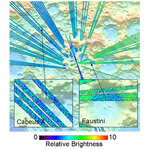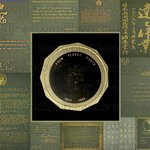Aerospace

People want to see awesome stuff.
That's the main idea behind this blog, and the interpretation of a recent report on people's decisions to share New York Times articles with friends (via Rycharde Mann). So, without further ado, here is some awesomeness:
1) From absolute zero to the plank temperature...a nice interactive graphic showing where we fit in the scheme of temperatures.
2) A visible sonic boom, as a rocket passes by a sundog (the rainbow splotch at ~1:55 in the video)

ESA’s comet chaser Rosetta has swung by Earth for the third and final time, skimming past our planet to pick up a gravitational boost for an epic journey to rendezvous with comet 67P/Churyumov-Gerasimenko in 2014.
Rosetta passed over the ocean just South of the Indonesian island of Java at exactly 08:45:40 CET with a speed of 13.34 km/s with respect to Earth and an altitude of 2481 km.
The successful swingby was confirmed at 09:05 CET and spacecraft operators have confirmed that the swingby provided a boost of 3.6 km/s.
Animation showing Rosetta's journey and the flyby geometry of…

Sprit and Opportunity: The U.S's Robot on Mars!! You've Had heard about 'Sprit and Opportunity' the twin robots that landed on Mars in 2004 by the Delta-2 Rocket. Sprit and Opportunity helped solve many problems of Mars!
Let's watch some videos!
See how Sprit and Opportunity's landing on Mars!

Wolfgang Fink, visiting associate in physics at the California Institute of Technology in Pasadena (Caltech, to you) says a paradigm shift in planetary exploration is coming - and it involves space robots.
Fink and a team at Caltech, the U.S. Geological Survey and the University of Arizona are developing software along with a robotic test bed that can mimic a field geologist or astronaut - the software, they say, will allow a robot to think on its own.
The way it works now, engineers command a rover or spacecraft to carry out certain tasks and then wait for them to be executed.…

Today, while thrift-shopping, I found an important component for our satellite building.
Yes, it's a rolling trunk, and I'll admit it's not the most exciting science prop. But there are four important details that make this an important detail in DIY satellite building.
1) Pragmatics. I need a place to store the satellite and components when I'm not working on it.
2) Conveyance. I need something to lug the kit around when I take it over to my friend's workshop, when we eventually get to final assembly.
3) Promotion. I need to be able to lug the satellite (or flight…
Antares DLR-H2 of the German Aerospace Center (DLR) became, on 7 July 2009, the world's first piloted aircraft to take off on power from fuel cells. The propulsion system of this aircraft was developed at the DLR Institute for Technical Thermodynamics in partnership with Lange Aviation, BASF Fuel Cells, and Serenergy (Denmark).
"We have improved the performance capabilities and efficiency of the fuel cell to such an extent that a piloted aircraft is now able to take off using it," said Prof. Dr-Ing Johann-Dietrich Warner, DLR's Chairman…

A new type of rocket propellant made from a mixture of water and nanoscale aluminum powder could be manufactured on the moon or Mars or any place remnant ice may exist, say researchers from NASA, the Air Force Office of Scientific Research, Purdue and Pennsylvania State University who believe their aluminum-ice, or ALICE, propellant could be used to launch rockets into orbit from Earth as a pit stop for long-distance space missions. Since it's greener than current propellants it will also be acceptable to those of you concerned about universal global warming(1).
Earlier this year ALICE…
After wrapping up the minutiae of funding, we're finally entering the lab for Project Calliope. Next week, I get to build a model ionosphere and replicate a spinning satellite to test what sort of music to expect.
In practice, this means rigging up a magnet to replicate ionospheric magnetic fields, putting a strobe for mimicking the Sun as seen by a rapidly spinning satellite, then seeing what sort of data my detectors spit out.
All instrument design requires you predict what range and variability your data has, then ensure the sensors you fly can cover that range. …

NASA's Lunar Reconnaissance Orbiter (LRO), launched on June 18th, 2009, will return more data about the Moon than any previous mission. The Lyman-Alpha Mapping Project (LAMP), developed by Southwest Research Institute, uses a novel method to peer into the perpetual darkness of the Moon's so-called permanently shadowed regions - the dark side of the moon.
LAMP is nearly identical to the successful Alice instruments developed by SwRI, already flying aboard the joint NASA/ESA Rosetta spacecraft, which is targeting the ancient comet Churyumov-Gerasimenko, and NASA's New Horizons…

Everyone is thorough about checklists of items they want to take on long trips - fewer people worry about things they are supposed to leave behind. But forty years ago, as the Apollo 11 astronauts were completing their checklist to leave the Moon they discovered that they had forgotten something important that wasn't supposed to return to Earth.
The astronauts had already left America's flag, the Stars and Stripes, and a plaque declaring "We Came in Peace for All Mankind" but as Buzz Aldrin climbed back into the Eagle lunar module, Neil Armstrong reminded him about a a tiny disc that…